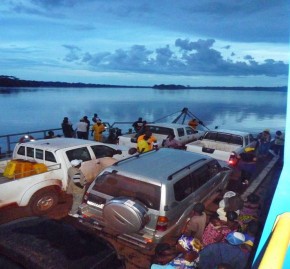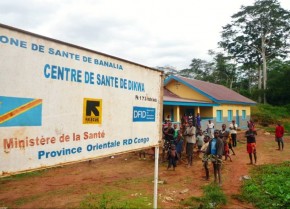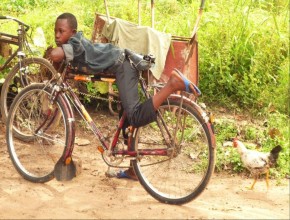Last week I went to see some road construction in a UK and World Bank joint-funded programme called ProRoutes. We headed out of Kisangani in DRC’s Oriental Province, driving some 270 km north of the Congo River through the tropical rainforest and overnighting on the banks of the Aruwimi in the sleepy town of Banalia. Only a few minutes out of Kisangani we met our first obstacle. During the night, a heavily laden lorry had misjudged some road works and gone over on its side. Traffic was backed up in both directions. The lorry driver sat defiant on the wheel of his truck, waiting for rescue.

Roads are a critical piece of social, economic, and communications infrastructure. Over the past 30 years, DRC’s road network has deteriorated, with whole roads disappearing altogether, or being reduced to tracks passable only on foot or bike. Working with the World Bank and with DRC road agencies, theUKis one of the donors investing in upgrading and rehabilitating roads as an essential step in reconnecting this huge and fractured country.
Chinese made bicycles are the most common vehicle on the road – even after the road has been repaired. The bikes carry enormous loads – tall woven baskets strapped either side of the rear wheel and filled to the brim with manioc. Two or three heavy white sacks filled with charcoal from the forest and destined for the kitchens of Kisangani. On the return trip, the bikes resemble a mobile shop, festooned with toiletries, plastic cups and buckets, and imitation croc shoes – signs of market activity deep in the forest.

The AruwimiRiverat Banalia is a formidable barrier. Fast flowing and half a kilometre wide. With no bridge, a well maintained ferry is the only way across. In the wheel house the captain edges the boat out into the current, pointing the bow upstream with just a fraction on the starboard engine to carve a long arc across to the other side. The captain uses the force of the river to nudge the ferry into shore.
The road crew works deep in the forest, pushing back the under-growth, tipping over enormous bamboo plants to reveal the road. Working with graders and soft-tired rollers they shape the red clay into a smooth cambered surface – easy to drive when dry, but turning to glass when it rains, which it does every day.

Back in Banalia we spend the night at the convent – the only available accommodation. The nuns provide us with supper – mashed plantain and some kind of bushmeat. The road is allowing forest animals to be poached at an alarming rate – up to 10 tonnes each month. Along with logging and charcoal production, the bush meat trade is one of the potentially negative consequences of the road programme that we will mitigate through ProRoutes.

As elsewhere in sub-Saharan Africa, roads are a major conduit for HIV. As people around the world marked World AIDS Day last Saturday, it was an opportunity to put a global spotlight on preventing new infections. The latest UN report shows a more than 50% reduction in the rate of new HIV infections across 25 low and middle-income countries – with more than half inAfrica, the region most affected by HIV.
Paradoxically, DRC’s lack of road infrastructure has prevented transmission of HIV – but as roads are rehabilitated there is a real risk that HIV will follow. Part of ProRoutes is working to inform local communities of the risks, give them access to information and condoms, and carefully monitor infection rates. This part of the programme also works with our health programme – we pass five health centres as we return to Kisangani. This is one example of how different parts of British aid in the DRC are working together to help poor people.

As we move back down to Kisangani, our speed increases. Good roads encourage fast driving, making road safety a major issue (Vicky Seymour's next blog post will focus on road safety in DRC). Communities live close to the road, with kids playing across the road between families and neighbours.
As we head back to Kisangani the local poultry choose the last possible second to dive across the road. They can run fast, and use their wings when necessary – but not all make it.

2 comments
Comment by Dick Komkech posted on
Amzaing story - keep the great work!
Comment by R Van Dooren posted on
I lived in Banalia in the 1950s at was then the Cotonco where my husband was Cotton Station Manager. This firm was the main employer there. Peanuts, cotton and coffee were the main agricultural income. There was a mission and church, a Hotel was built while we were there, a few shops, with basic food, mostly tinned. The ferry was in place, with a man called Camile. The roads were sometimes difficult especially the rainy season, but the main roads were kept reasonably passable. We spent 5 happy years there from 52 to 57 and have many photos and film.